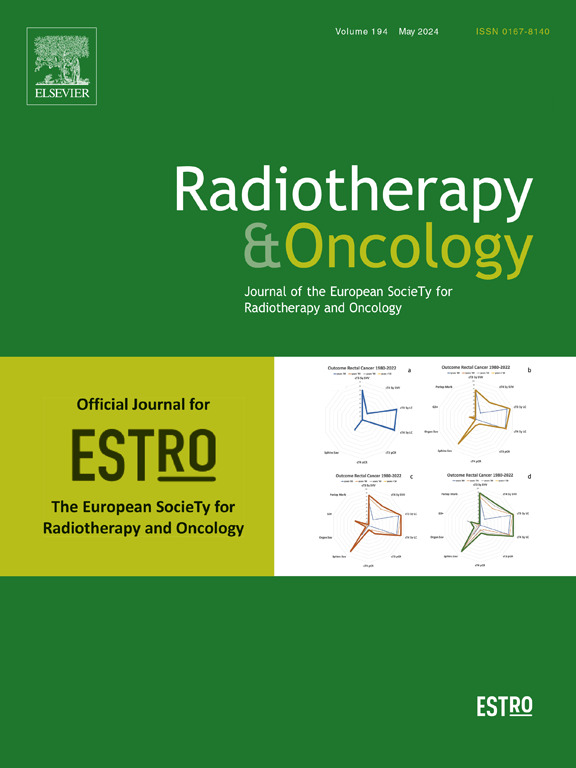Optimizing fractionation schedules for de-escalation radiotherapy in head and neck cancers using deep reinforcement learning
IF 4.9
1区 医学
Q1 ONCOLOGY
引用次数: 0
Abstract
Purpose
: Patients with locally-advanced head and neck squamous cell carcinomas (HNSCCs), particularly those related to human papillomavirus (HPV), often achieve good locoregional control (LRC), yet they suffer significant toxicities from standard chemoradiotherapy. This study aims to optimize the daily dose fractionation based on individual responses to radiotherapy (RT), minimizing toxicity while maintaining a low risk of LRC failure.
Method:
A virtual environment was developed to simulate tumor dynamics under RT for optimizing dose schedules. Patients predicted to maintain LRC were selected for de-escalation experiments. The proliferation saturation index (PSI) and linear-quadratic model were used to predict responses. A deep reinforcement learning (DRL) agent optimized fractionation schemes by interacting with the simulation environment, aiming to reduce the OAR’s biologically effective dose (BED) while preserving LRC. The impact of model uncertainty was analyzed and a support vector machine (SVM) model was used to segment parameter space and identify patients more robust to noise.
Results:
Personalized de-escalation plans were compared to conventional RT in a cohort of 5000 virtual patients. Personalized fractionation reduced the tumor dose and OAR’s BED by 29%, with an average OAR BED reduction of 5.61 ± 2.96 Gy. Prognostic outcomes were nearly identical, with 99.80% of patients in the low-risk LRC failure group. Model uncertainty impacted dosimetric indicators and prognosis, but the high-BED benefit group showed greater robustness to noise. SVM decision boundaries defined parameters range for patient selection.
Conclusion:
Optimizing fractionated doses based on patient responses minimizes toxicity while maintaining LRC in HNSCCs. Stratifying patients can mitigate model uncertainty and reduce treatment risks.
利用深度强化学习优化头颈部癌症降级放疗的分次计划。
目的:局部晚期头颈部鳞状细胞癌(HNSCCs)患者,特别是与人乳头瘤病毒(HPV)相关的患者,通常可以获得良好的局部区域控制(LRC),但他们在标准放化疗中遭受显着的毒性。本研究旨在优化基于个体放射治疗反应(RT)的日剂量分配,在保持低LRC失败风险的同时最小化毒性。方法:建立虚拟环境,模拟肿瘤在放射治疗下的动态变化,优化给药方案。预测维持LRC的患者被选择进行降级实验。利用增殖饱和指数(PSI)和线性二次模型预测反应。深度强化学习(DRL)代理通过与模拟环境相互作用来优化分馏方案,旨在降低桨叶的生物有效剂量(BED),同时保持LRC。分析了模型不确定性的影响,采用支持向量机(SVM)模型分割参数空间,对噪声具有更强的鲁棒性。结果:在5000名虚拟患者的队列中,将个性化降级计划与传统RT进行了比较。个体化分离使肿瘤剂量和OAR的BED降低29%,平均OAR BED降低5.61±2.96 Gy。预后结果几乎相同,99.80%的患者在低风险LRC失败组。模型不确定性影响剂量学指标和预后,但高bed效益组对噪声表现出更强的稳健性。支持向量机决策边界定义了患者选择的参数范围。结论:在HNSCCs中,根据患者反应优化分级剂量可以在维持LRC的同时将毒性降到最低。分层患者可以减轻模型的不确定性,降低治疗风险。
本文章由计算机程序翻译,如有差异,请以英文原文为准。
求助全文
约1分钟内获得全文
求助全文
来源期刊

Radiotherapy and Oncology
医学-核医学
CiteScore
10.30
自引率
10.50%
发文量
2445
审稿时长
45 days
期刊介绍:
Radiotherapy and Oncology publishes papers describing original research as well as review articles. It covers areas of interest relating to radiation oncology. This includes: clinical radiotherapy, combined modality treatment, translational studies, epidemiological outcomes, imaging, dosimetry, and radiation therapy planning, experimental work in radiobiology, chemobiology, hyperthermia and tumour biology, as well as data science in radiation oncology and physics aspects relevant to oncology.Papers on more general aspects of interest to the radiation oncologist including chemotherapy, surgery and immunology are also published.
 求助内容:
求助内容: 应助结果提醒方式:
应助结果提醒方式:


